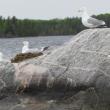Gulls of spring
Gulls are a nearly constant part of our Maine landscape, at least in the southern and coastal portions of the state. So it’s no wonder that most people probably don’t realize they are migratory birds. In fact, vast numbers of a variety of species of gulls migrate south in winter and back north again each spring, to and from breeding grounds across Canada and the northern United States.
In the case of the familiar gray-backed herring gull and the imposingly large great black-backed gull, it’s perfectly understandable if you didn’t know that some or many of the individuals you see in winter are not the ones you saw in summer. That’s because in both of these gull species, large numbers move south from Canada to spend the winter along our coasts and at the gull-equivalent of a fast-food joint — landfills.
Herring and great black-backed aren’t the only gulls the migrate. We have written here before about some of the gull species that do not occur here in Maine in summer at all but, rather, migrate south from Canada to spend winters here, birds like Iceland and glaucous gulls.
Then there those black-hooded, noisy laughing gulls that love to try to swoop in and steal French fries, or even worse, a lobster roll, from the hands of an unsuspecting summer visitor, who thought they’d enjoy a meal on the deck of a local eatery.
Some of you may have noticed that laughing gulls disappear in the winter. They migrate down to the southeastern U.S. and parts of the Caribbean for the winter, returning in late March and April to their nesting islands here on the Maine coast. Ring-billed gulls, smaller and close lookalikes to the herring gull, but with yellow legs and a black ring around the bill, generally stay around in coastal Maine in small numbers but higher numbers appear in spring as the migrants make their way north.
Beginning in March on warmer calm days or days with a balmy south wind, if you look up into the sky, you can see gulls high up in the air circling and giving a different, longer call that you don’t hear in winter. At inland locations where there are fewer wintering gulls, these high flyers can be particularly striking. These are likely migrant gulls heading north to their summer nesting grounds. Herring Gulls breed in small colonies across Canada’s northern Boreal Forest Region, at the millions of lakes that are sprinkled across that vast landscape. They, and other species, also breed across the northern marine coastlines of Canada. In isolated communities scattered across northern Canada where people endure a long and very cold winter, one of the early signs of spring is often the arrival of migrant gulls that may show up even when most water is still frozen solid; this can be well into June in those high latitude locations.
We may think of our first sighting of a flock of Canada geese or American robins as the sure sign of spring in our area (though both actually winter in the state), and sightings of either species would similarly be welcomed in the Far North of Canada. But it is those first sightings of returning gulls that give hope to many Canadians in some northern regions — gulls that may have spent the winter with us here in Maine and, like many songbirds, waterfowl and others, can be a great reminder of the mysteries of bird migration.
Event Date
Address
United States

























